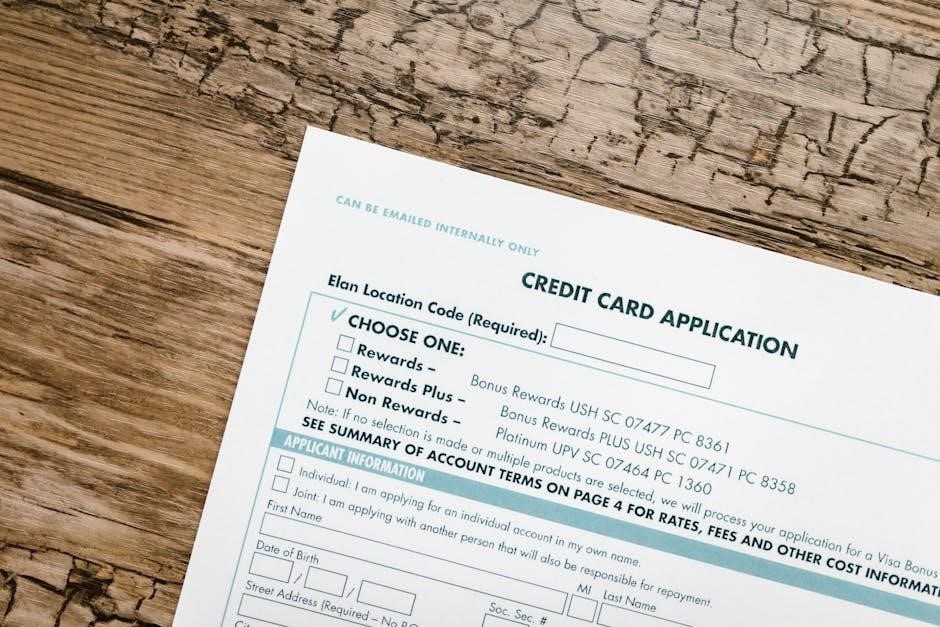Credit card processing is the backbone of modern commerce, enabling businesses to accept payments securely. It involves verifying card details, ensuring funds, and transferring money seamlessly, while maintaining security and efficiency for both merchants and consumers.
1.1 What is Credit Card Processing?
Credit card processing is the process of handling transactions where a customer uses a credit card to pay for goods or services. It involves verifying the card’s validity, checking available funds, and securely transferring money from the cardholder’s account to the merchant’s account. This process is facilitated by payment networks, banks, and processors, ensuring seamless and secure transactions for both parties.
1.2 Importance of Credit Card Processing for Businesses
2.1 How Credit Card Transactions Work
A credit card transaction involves several steps: authorization, settlement, and funding. Authorization verifies the cardholder’s details and available funds. Settlement clears the transaction, and funding transfers the money to the merchant. The process is secure, efficient, and ensures seamless payment processing for businesses and customers alike, making it a cornerstone of modern commerce.
Understanding the Basics of Credit Card Processing
Understanding the basics of credit card processing involves recognizing how transactions are streamlined, secured, and facilitated through advanced technology and financial networks.
A credit card transaction involves several steps, starting with the customer presenting their card for payment. The merchant uses a payment terminal or online gateway to process the transaction. The card details are sent to the payment processor, which communicates with the issuing bank to verify funds and check for fraud. Once approved, funds are transferred from the cardholder’s account to the merchant’s account, completing the transaction securely and efficiently through advanced technology and financial networks.
2.2 Key Players in Credit Card Processing
The key players in credit card processing include issuing banks, which provide cards to consumers, and acquiring banks, which handle transactions for merchants. Payment gateways facilitate online transactions, while merchant service providers offer processing solutions. Additionally, card networks like Visa and Mastercard manage the infrastructure, ensuring seamless communication between all parties to complete transactions efficiently and securely.
2.3 The Role of Issuing and Acquiring Banks
In credit card processing, issuing banks issue credit cards to consumers, authorize funds, and verify card legitimacy. Acquiring banks manage merchant accounts, facilitate transaction settlements, and transfer funds to merchants. Together, they ensure secure and efficient transaction flow, maintaining trust and stability in the payment ecosystem while adhering to industry standards and regulations for seamless operations.

Credit Card Processing Fees: A Comprehensive Breakdown
Credit card processing fees are charges merchants pay for accepting card payments. These fees vary by provider and include interchange, assessment, and markup rates, impacting profitability. Understanding fee structures helps businesses optimize payment costs effectively while maintaining seamless transactions and customer satisfaction.
3.1 Types of Credit Card Processing Fees
Credit card processing fees include interchange fees, assessment fees, and markup rates. Interchange fees are paid to the cardholder’s bank, assessment fees go to the card network, and markup fees are set by processors. Understanding these fee types helps businesses identify and reduce payment processing costs effectively, ensuring transparency in pricing and optimizing profit margins for merchants of all sizes.
3.2 How to Optimize and Reduce Processing Fees
To minimize processing fees, businesses can negotiate rates with providers, adopt tiered pricing models, or implement cost-effective solutions like surcharging. Optimizing transaction processing by ensuring accurate data entry and leveraging technology can also reduce costs. Additionally, understanding fee structures allows businesses to choose the most cost-effective plans tailored to their transaction volume and payment methods, ultimately enhancing profitability and financial efficiency.

Selecting the Right Credit Card Processing Provider
Selecting the right provider involves evaluating fees, contract terms, and customer support. Ensure transparency in pricing, check for hidden charges, and prioritize providers offering robust security features and scalability to meet your business needs;
4.1 Evaluating Merchant Service Providers
Evaluating merchant service providers involves assessing their fee structures, contract terms, and customer support. Consider transparency in pricing, hidden charges, and the range of payment methods offered. Security features, scalability, and integration with existing systems are crucial. Additionally, look for providers offering specialized solutions for small businesses, ensuring they align with your specific needs and growth potential.
4.2 Understanding Merchant Agreements and Contracts
Merchant agreements outline terms, fees, and responsibilities for credit card processing. Carefully review pricing models, contract lengths, and termination clauses. Look for transparency in fees, avoiding hidden charges. Understand liability for disputes and ensure compliance with industry standards. Negotiate terms that align with your business needs, and be aware of potential penalties for early termination or non-compliance.

Security and Fraud Prevention in Credit Card Processing
Secure transactions rely on EMV technology, encryption, and tokenization to protect data. Implement best practices like card verification and fraud detection tools to minimize risks and ensure compliance.
5.1 Best Practices for Secure Credit Card Transactions
To ensure secure credit card transactions, businesses should implement EMV technology, use encrypted payment gateways, and adopt tokenization. Regularly updating POS systems, training staff on security protocols, and conducting fraud audits are essential. Additionally, enforcing card verification value (CVV) checks and monitoring transactions for suspicious activity can significantly reduce the risk of data breaches and fraud.
5.2 Understanding EMV Technology and Its Impact
EMV (Europay, Mastercard, Visa) technology enhances payment security using chip cards. It reduces fraud by creating unique transaction codes, making counterfeit card replication difficult. Globally adopted, EMV has significantly lowered counterfeit fraud rates, ensuring safer transactions for businesses and consumers alike, while fostering trust in credit card processing systems worldwide.

The Role of Technology in Modern Credit Card Processing
Technology has revolutionized credit card processing by enabling faster, more secure transactions. Payment gateways, POS systems, and automation streamline operations, reducing manual errors and accelerating cash flow.
6.1 Payment Gateways and Their Functionality
Payment gateways are secure platforms that facilitate real-time credit card transactions between merchants and banks. They encrypt sensitive data, ensuring secure processing of payments online or in-person. Gateways like Authorize.net and Stripe integrate with POS systems, enabling businesses to accept payments seamlessly. They also support recurring billing, tokenization, and fraud detection, making them essential for modern commerce. Their functionality streamlines payment processing, reducing manual errors and enhancing customer convenience.
6.2 Point of Sale (POS) Systems and Their Integration
POS systems are essential tools for businesses, streamlining credit card transactions and integrating with payment gateways, inventory management, and accounting software. Modern POS systems support contactless payments, mobile devices, and loyalty programs, enhancing customer experience. They also provide real-time reporting and analytics, helping businesses track sales and optimize operations. Seamless integration with payment processing ensures efficient transaction handling and improved operational efficiency.
6.3 The Rise of Contactless Payments
Contactless payments are revolutionizing the way we transact, offering speed and convenience through NFC technology. Tapping cards or devices replaces traditional swiping, reducing physical contact and enhancing hygiene. The shift towards touchless interactions, especially post-pandemic, accelerates adoption. Integration with mobile wallets like Apple Pay boosts accessibility. Security remains robust with encryption, though transaction limits exist for added safety. With infrastructure expanding and wearables emerging, contactless payments are poised to dominate future transactions, blending seamlessly into daily life.

Preventing Chargebacks and Disputes
Preventing chargebacks and disputes requires proactive monitoring, clear transaction documentation, and prompt communication with customers. Implementing robust verification processes and addressing issues swiftly can reduce disputes and protect revenue.
7.1 Understanding Chargeback Processes
A chargeback occurs when a cardholder disputes a transaction, triggering a reversal of funds. Common reasons include unauthorized charges, goods not received, or service issues. The process involves the cardholder initiating a dispute, the issuing bank investigating, and funds being withheld from the merchant. Understanding this process is crucial for businesses to monitor transactions, resolve disputes promptly, and minimize financial losses.
7.2 Strategies to Minimize Chargeback Risks
To reduce chargeback risks, businesses should implement clear transaction descriptions, obtain signatures, and provide detailed receipts. Monitoring for fraudulent activity, addressing customer concerns promptly, and ensuring accurate billing are essential. Offering refunds or resolutions before disputes escalate can prevent chargebacks. Merchants should also maintain open communication with customers and regularly review transaction patterns to identify potential issues early.

Credit Card Processing for Small Businesses
Credit card processing is essential for small businesses to streamline transactions, enhance customer satisfaction, and maintain financial security. It offers efficient, cost-effective solutions tailored to their needs.
8.1 How to Get Started with Credit Card Processing
Getting started with credit card processing involves selecting a reliable provider, understanding fees, and setting up necessary equipment like POS systems or payment terminals. Ensure compliance with security standards to protect customer data and maintain trust. This step-by-step approach helps small businesses integrate seamless payment solutions, enhancing operational efficiency and customer satisfaction.
8.2 Tips for Reducing Costs for Small Businesses
Small businesses can reduce credit card processing costs by negotiating rates with providers, understanding fee structures, and minimizing disputes. Optimizing transactions, batching payments, and adopting cost-effective technologies like POS systems also help. Regularly reviewing statements ensures transparency, while avoiding unnecessary fees by understanding chargeback processes further enhances savings, allowing businesses to allocate resources more efficiently.
The Future of Credit Card Processing
The future of credit card processing involves advanced technologies like digital wallets, cryptocurrency, and contactless payments, enhancing security, speed, and convenience for transactions globally.
9.1 Emerging Trends in Payment Technology
The payment landscape is evolving rapidly, with trends like AI-driven fraud detection, blockchain for transparency, and biometric authentication enhancing security. Contactless payments, mobile wallets, and IoT-integrated solutions are gaining traction, offering seamless transactions. Tokenization and decentralized finance (DeFi) are also reshaping traditional payment systems, ensuring faster, more secure, and globally accessible financial processes for businesses and consumers alike.
9.2 The Impact of Digital Wallets and Cryptocurrency
Digital wallets like Apple Pay and Google Wallet are transforming payments, offering convenience and security. Cryptocurrency, such as Bitcoin, enables fast, low-fee cross-border transactions, though volatility and regulatory challenges persist. These technologies are reshaping credit card processing, reducing reliance on traditional systems while introducing new opportunities for global commerce and financial inclusion, despite adoption hurdles and security concerns.
Troubleshooting Common Issues
Troubleshooting common issues in credit card processing is crucial for seamless transactions. Addressing errors, chargebacks, and customer complaints requires quick solutions and skilled support teams.
10.1 Resolving Common Credit Card Processing Errors
Common credit card processing errors include declined transactions, connectivity issues, and batch processing failures. To resolve these, merchants should verify card details, check network connections, and ensure proper terminal functionality. Regularly updating payment terminals and training staff on error handling can prevent recurring issues. Monitoring transaction logs and addressing errors promptly helps maintain smooth operations and customer satisfaction.
10.2 Addressing Customer Complaints and Concerns
Addressing customer complaints and concerns is crucial for maintaining trust and satisfaction. Common issues include declined transactions, payment disputes, or processing delays. Listen actively, provide clear explanations, and offer solutions promptly. Ensuring transparency in fees and transaction processes can prevent misunderstandings. Offering alternative payment methods and maintaining open communication channels helps resolve issues efficiently, fostering long-term customer loyalty and a positive business reputation.
Credit card processing is vital for modern commerce, ensuring secure and efficient transactions. Mastery of its evolving landscape future-proofs businesses, driving sustained growth and customer satisfaction.
11.1 Final Thoughts on Mastering Credit Card Processing
Mastering credit card processing is crucial for businesses to enhance efficiency, security, and customer satisfaction. By staying informed about industry trends and best practices, businesses can optimize their payment systems, reduce costs, and adapt to new technologies. Understanding fee structures, preventing fraud, and minimizing chargebacks are key to long-term success in an ever-evolving payment landscape.


